Five periodical reports on my experience as intern at Tobacco Caye Marine Station:
• Report 1: First Experiences
• Report 2: “Adopt a Reef Friend” Project
• Report 3: Lionfish Research
• Report 4: Coral Bleaching
• Report 5: Final Experiences
May 30th 2022 – Report 1: First Experiences
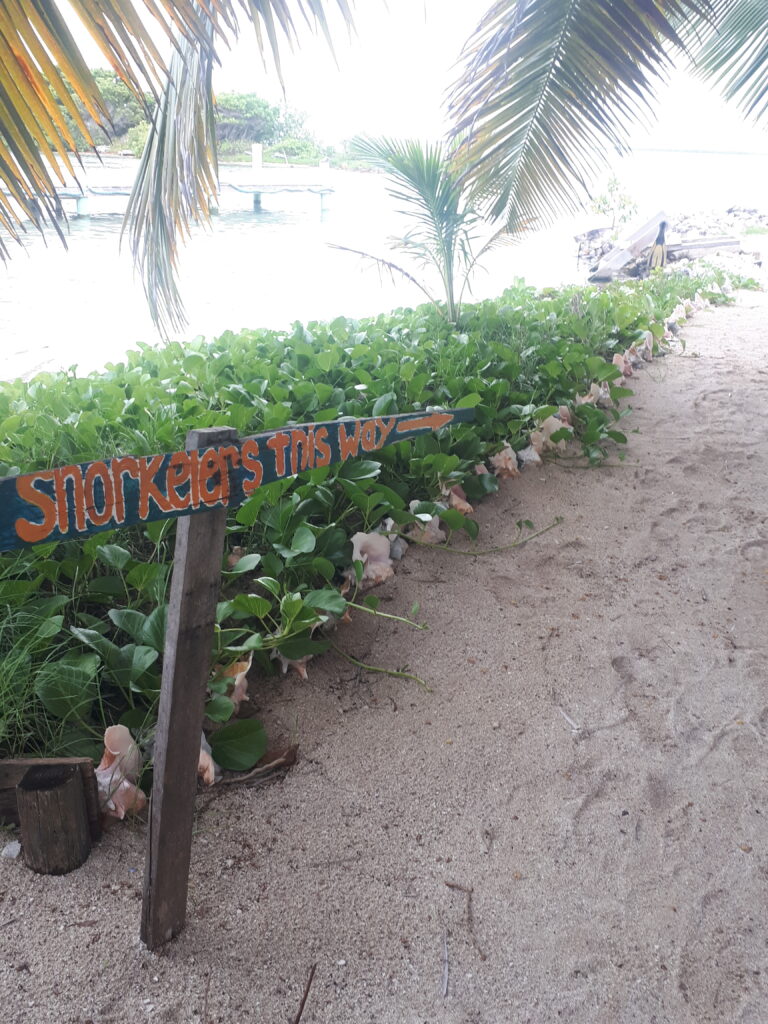
The idyllic Tobacco Caye is located right by the second biggest coral reef in the world, along with being near mangroves and sea-grass beds. Three different ecosystems that complement each other and the biodiversity present in the Caribbean Sea. It is incredible to walk around the coast of Belize (and therefore virtually any island) and find coral fragments of their bony and intricate “skeleton”, made of Calcium Carbonate (CaCO3) by the coral as it grows.
The two biggest hazards of living on the island are: Falling (and deadly) coconuts and stub toes on what once were corals. Tobacco Caye Marine Station is a not-for-profit organization, amazingly run “behind the scenes” by Zara Troughton, the Business Manager. Research Station Manager James Troughton provides the educational lectures, intro and guiding during snorkel trips to visiting study abroad students, while also and collecting the data for the station’s three main research projects: Invasive Lionfish, Marine Debris data and Coral Bleaching & Disease data.
The word “Caye” comes from the Mayan word for “sand accumulation on top of the reef”
James Troughton, Marine Biologist & Tobacco Caye Marine Station Manager
Corals are animals that form colonies, and each individual organism is called a Polyp. I had never seen corals before and I was amazed by the incredible biodiversity that they sustain, while also being puzzled by it. Back home (West Coast of Canada, on Vancouver Island) I am familiar with the marine animals and the role they play in their ecosystem, while here at Tobacco Caye in Belize, they may play similar roles, but belong to a completely different range of “cast members”. Corals come in an endless variety of shapes (boulder coral, branching coral, soft coral, plate coral, etc.) and colours. Seven unique structures of stony corals are present in Belize, out of an estimated 10 possible structures existent in the world. These incredible animals have been on Earth for at least 400 million years, meaning they survived 3 out of the 5 mass extinctions that happened on Earth.
Note: fire-corals are not *true* corals, but Hydrozoans (evolutionary “cousins” of jellyfish) and sting due to the presence of cnidocytes that store “micro harpoons” – called nematocysts – causing burning rashes (which are best treated with vinegar).
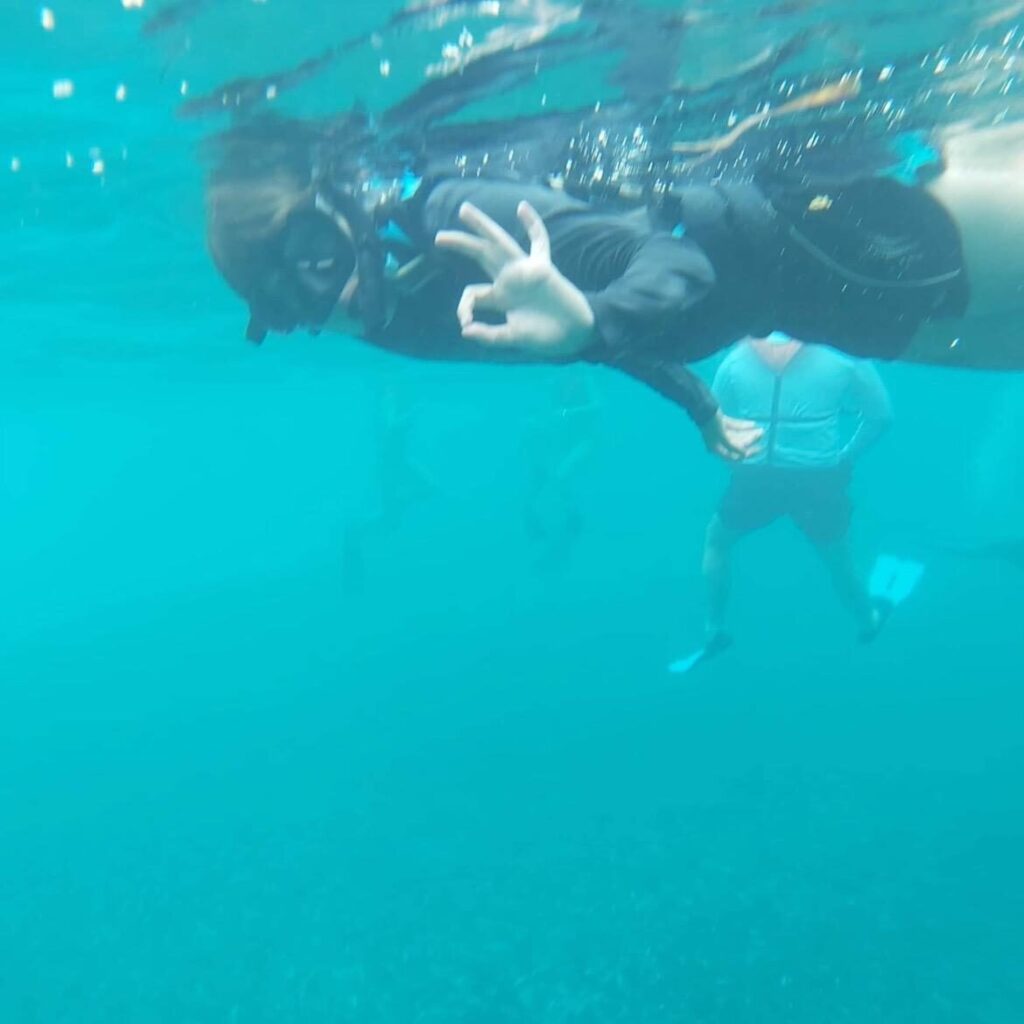
I am not the greatest swimmer, so I was initially quite nervous about snorkelling, needing to make sure I breathe deep and slowly to not panic and be able to enjoy the view calmly and fully. Nervousness came back to bite me during the night snorkel, where the feeling of being in awe with the vastness and darkness of the sea met the breathtaking feeling of powerlessness and being small in a world that isn’t ours. Nonetheless, I have been getting better slow and steady!
Snorkelling unexpected fun fact: I have the tendency of being “hypnotized” by Sponges (animals that belong to the Phylum Porifera), having to catch up with the group a few times!
Right by Tobacco Caye, there is a Coral Reef crest (a “graveyard” of stony corals that have been damaged by hurricanes and storms), which serves as wave-breakers to the Caye and also an oceanic trash accumulation point. When going to this site with students to collect trash (as well as collect data of which type of trash was being found and removed) the overwhelming amount of garbage that has washed up is heartbreaking. That area is part of the UNESCO World Heritage Belize Barrier Reef designated in 1996 and requires a permit to be able to go there.
Snorkelling through the mangrove, seeing their roots underneath water, that not only to serve as habitat for countless species of flora and fauna, but also serve as a barrier against erosion, is also an amazing experience. The biggest example of that is Bird Island, which has been quite literally disappearing in the past 25 years due to erosion caused by dredging (the remaining trees are currently bare of leaves and the sandy ground is completely underwater). At one of the mangrove snorkel sites, I was able to spot dozens of the unusual upside-down jellyfishes (Cassiopea sp.) making the sea floor look like a “pom-pom garden”. They stay in one place at the bottom of the sea floor, with their bells pointing down and their tentacles floating up.
A huge accumulation of Sargassum, a brown alga that floats at the surface of the sea because of their small air-filled air pockets (pneumatophores), causes some distress in the locals and tourists due to their unpleasant rotting smell. A small amount of Sargassum is normal and healthy for the seas, however their reproduction has been propelled by the effects of global warming. Their leaves/blades are jagged, which favours their entanglement, but make snorkelers quite unhappy. Sargassum originated from the Sargasso Sea, the only one in the world without any land borders, and is the size of Australia.
Some of the incredible animals observed during the snorkel trips: Midnight Parrotfish (Scarus coelestinus), Rainbow Parrotfish (Scarus guacamaia), Feather-Duster Worm (Sabellastarte magnifica), Brittle Stars, the huge Queen Conch (Aliger Gigas), sharp nose puffer fish (Canthigaster rostrata), Porcupine Fish (Diodon hystrix), a Caribbean reef squid (Sepioteuthis sepioidea), a Green Moray Eel (Gymnothorax funebris), Ctenophores such as the Sea Walnut (Mnemiopsis leidyi), a couple of planarians (flatworms), impressive Giant Hermit Crabs (Petrochirus diogenes), Gray Angelfish (Pomacanthus arcuatus), Yellow Stingray (Urobatis jamaicensis), Whiptail Stingray (Styracura Schmardae) and the Sea Pearl (Valoma ventricosa), the biggest single celled alga in the world, which I did not expect to see and only knew about it due to “viral” posts on social media. Birdwise, the Brown Pelican (Pelecanus occidentalis) and the Magnificent Frigatebird (Fregata magnificens) caught my attention.
These past 10 days seem to have lasted a month! Not only due to the demanding long hours of work under equatorial heat, but especially due to the many different activities completed, the different groups we’ve welcomed, the various sites we have visited (Bread and Butter Caye, Emily’s Cut, Long Reef, Tobacco Range and more!), the amount of information learned, and the eagerness to share it all with the world!
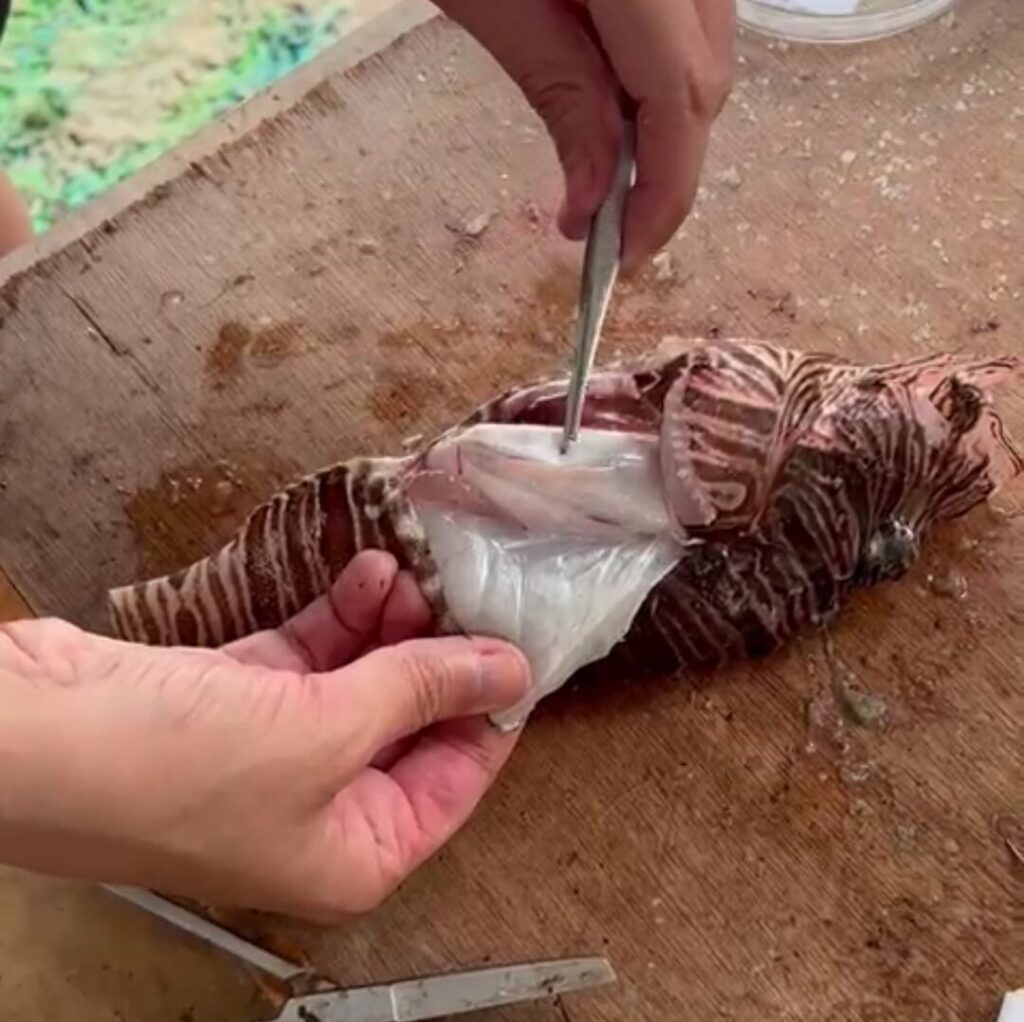
Lionfish Invasion: Lionfish (Pterois sp.) are gorgeous fish that originally live in the Indio-Pacific Ocean, but due to their looks used to be common in the pet trade (still present but less popular). Unfortunately, being an excellent predator, it would eat all of its aquarium “buddies” and may grow up to 45cm (almost 18”), causing humans to simply throw them in the sea once they didn’t want them anymore. Lionfish do not have any natural predators in the Caribbean Sea, they can live up to 30 years, the females are able to lay up to 50,000 eggs every four days and they are not picky eaters. Those factors combined make them a very successful invasive animal (17x denser population here than their native range), causing devastating consequences to the marine biodiversity inhabiting the coral reefs in Belize. They are venomous, containing 18 venomous spines throughout its fins (13 on the dorsal fin, 1 in each pelvic fin and 3 on its anal fin). TCMS has collaborated with the Lionfish Patrol, catching Lionfish and collecting data on the fish caught. The Marine Station also incentives the locals of the Caye to go out and hunt for those solitary fish (they do not live in large groups/schools) and bring them back to the Station, being compensated financially by the pound for a fish that would otherwise not have as much market demand. I will be part of the committee responsible for organizing the next Lionfish Tournament that will happen at the end of July. I am as intimidated as I am excited for this incredible and challenging opportunity!
Note: I was surprised by not encountering various parasites while dissecting Lionfish. Out of a couple dozen fish dissected, only one had a parasite (isopod inside mouth).
HIGHLIGHTS
- Bioluminescence (by microorganisms called dinoflagellates) during night snorkel
- Lionfish dissection
- Seeing a brittle star up-close
- Swimming flatworm (looks like a “dancing ribbon”)
“DOWN”LIGHTS
- Devastation on Bird Island
- Lionfish Invasion
- Sargassum Accumulation
- Garbage Accumulation at the coral reef “graveyard”
June 11th 2022 – Report 2: “Adopt a Reef Friend” Project
BACKGROUND (Where the idea came from): During the Covid-19 closure of student activities, many countries’ borders were closed and travels were essentially halted for a long period of time. James & Zara Troughton (Marine Station Manager and Business Manager) were, like many other businesses, finding themselves in a difficult situation with no Study Abroad students visiting the island from March 2020 until May 2021. They needed to be creative with how to continue their educational activities, transitioning to the online format. One of the solutions was to offer online/virtual Tobacco Caye Island tours and with that came the possibility of live presentations and lectures.
As TCMS was exploring the prospect of virtual learning programs, a Marine Ecology online session was requested by Dave Cox, from Lincoln Land College (Illinois, USA). Dave then introduced TCMS to Michael Windelspecht from Inspire EdVentures (an educational experience company), from where the Tobacco Caye Marine Station’s virtual and interactive live tours were born.
INTRO (Goal of project): Tobacco Caye Marine Station is a not-for-profit organization that is funded mainly via Education Abroad students, sale of gift shop items and kind donations made in person or via their GoFundMe page.
In the near future, TCMS will launch the “Adopt a Reef Friend” program in collaboration with Inspire EdVentures, where a monetary contribution will bring Tobacco Caye and its marine life to people who wouldn’t otherwise be able to experience its wonders. This inspiring initiative is targeted to a wide audience, such as young Biology students, it supports K-12 scholarships, reaches elderly community members (such as folks from Appalachian Brian Estates retirement home in North Carolina, USA), and overall makes it possible for any marine environment enthusiasts to participate in the TCMS’ projects anytime, anywhere.
IMPORTANT NOTE: To be unconditionally clear, there is no real-life adoption in the sense that wild animals will be removed from their natural environment nor going to be cared for, monitored, nor fed by the TCMS Team. The “Adopt a Reef Friend” is a symbolic adoption that intends to bring awareness and information to the public, while financially supporting TCMS’ research projects.
DESIGN: Given my Graphic Design background (2013 Degree & experience working in print shops as well as a freelance graphic designer) I was excited to create the template for the postcards the reef creatures will “send” to their supporters! Each intern was responsible for picking reef creatures and creating a first-person description of it, with interesting and fun facts about each one of them. The template I created was shared with the other interns so that their content could be applied to the same uniform and harmonized layout, maintaining TCMS’ respectability as an institution and brand. There is no limit in the number of postcards that can be created, as the template and software will be available to the TCMS Management Team so they are able to continue with the project even after my internship has come to an end.
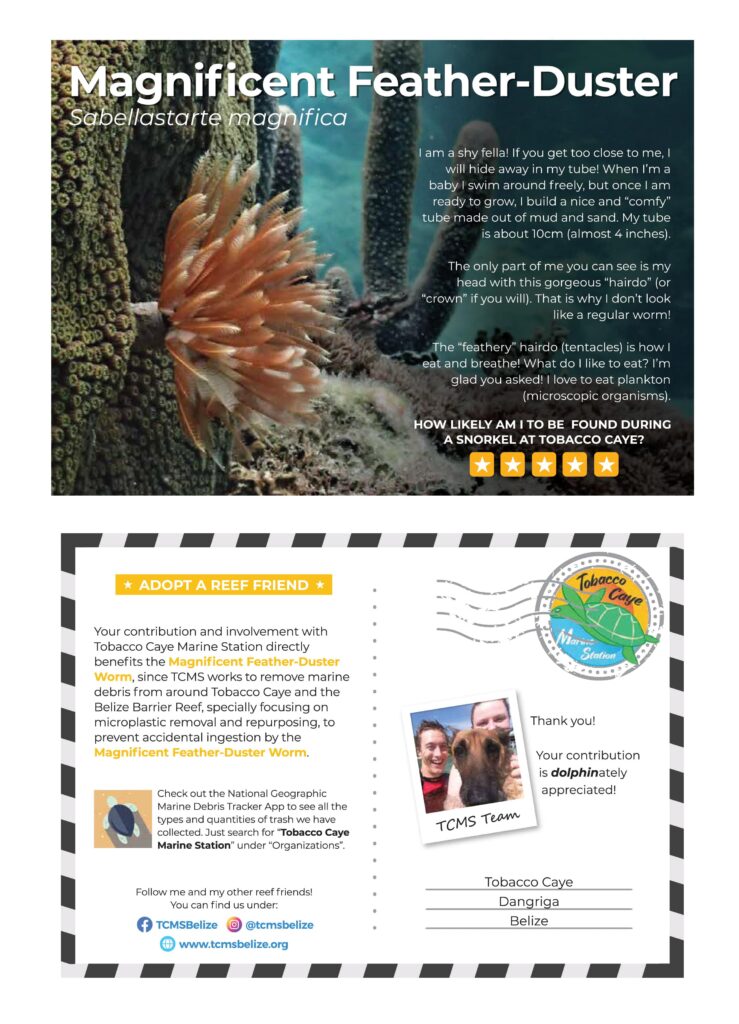
My reef creatures of choice were: Magnificent Feather-Duster Worm (Sabellastarte magnifica), Sponge Brittle Star (Ophiothrix suensoni) and the Flamingo Tongue Snail (Cyphoma gibbosum). The reason I chose those animals are simply due to my fascination for the tiny and often overlooked invertebrate creatures. I personally find them just as amazing as other bigger animals found in the ocean (megafauna). I was able to come across all three of them during my snorkeling trips as an intern here at Tobacco Caye. The Magnificent Feather Duster Worms are easily found not only around corals, but also near docks and are plentiful in the submerged Red Mangrove (Rhizophora mangle) prop-roots. I’ve seen a Sponge Brittle Star exactly where they are expected to be: in a sponge! I dove to observe a Feather Duster Worm closely and to create a small current with my hands to get it to hide inside its tube. That worm was inside a sponge and right behind it, there was a Brittle Star hiding! I’ve most commonly seen the Flamingo Tongue Snails on the gorgeous Purple Sea Fan corals (Gorgonia ventalina) and with their contrasting colours, they are relatively easy to find. It was also important to create postcards for two medium-sized animals that were easier to be spotted, in which case I chose the Trumpet Fish (Aulostomus maculatus) and the Gray Angelfish (Pomacanthus arcuatus). Other important “Reef Friends” to be added to the postcard collection that were made by me are: Spotlight Parrotfish (Sparisoma viride), Peacock Flounder (Bothus mancus), Porcupine Fish (Diodon hystrix) and Loggerhead Turtle (Caretta caretta).
The animals chosen by the other interns are (so far): Nurse Shark (Ginglymostoma cirratum), Spotted Eagle Ray (Aetobatus narinari) and the Caribbean Reef Octopus (Octopus briareus). It will be possible to access those once they are all up online at the TCMS website as well as the Inspire EdVentures website, in which case I will surely update this blog post with the link for easier access.
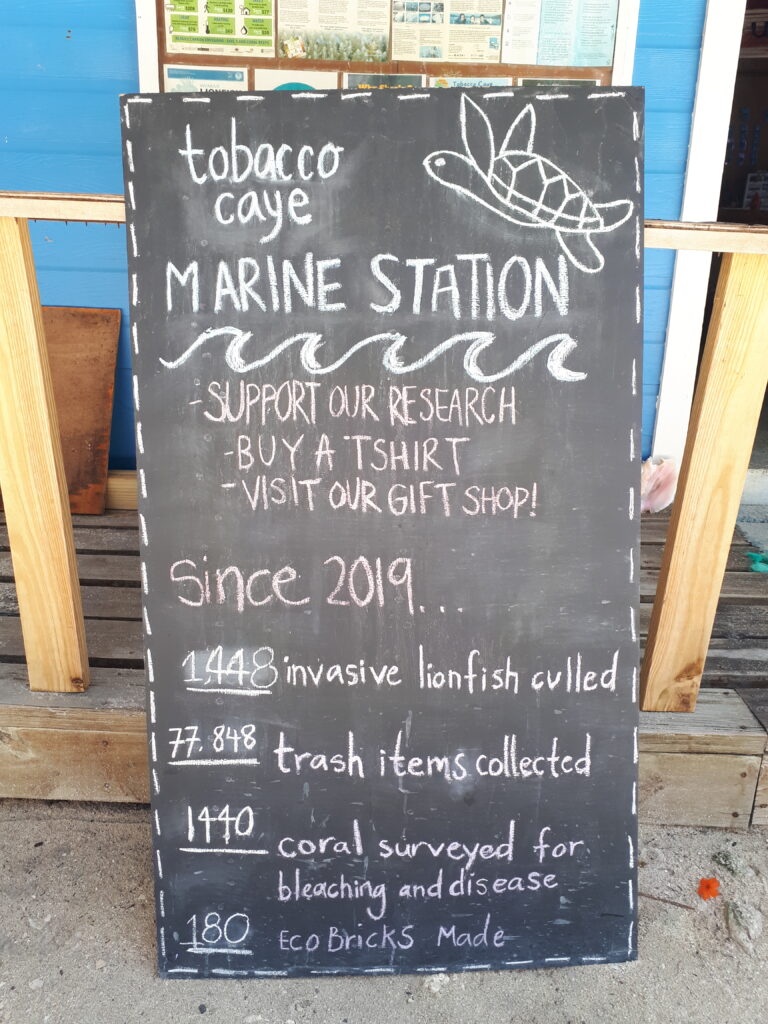
Understanding that some animals (like sharks and turtles) are more popular than others (worms and snails), the wide range of diversity will account for different levels of donation amounts, allowing the program to be as accessible as possible. Another key factor taken into consideration when defining the prices for each reef creature’s “Adoption” will be its ecological role in the reef, as well as how vulnerable they are to the research measurables collected (such as trash and Lionfish collection, exemplified by the TCMS board on the right, from the end of May 2022). Each reef creature is directly impacted/helped by a specific research project.
The information added to the “Adopt a Reef Creature” postcards were sourced and supported by the Reef Creature Identification – Florida, Caribbean, Bahamas – by Paul Humann and Ned DeLoach very complete guides.
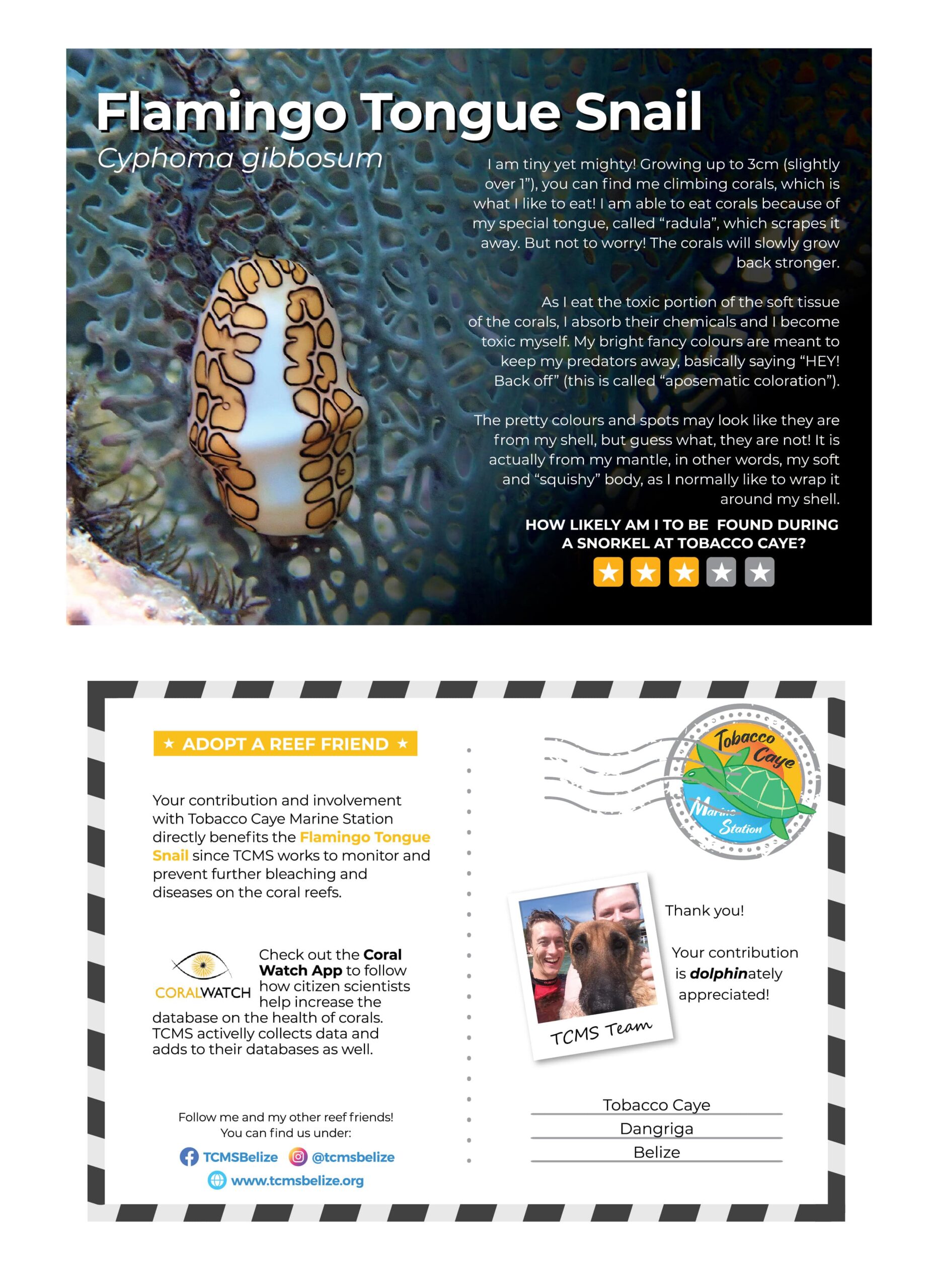
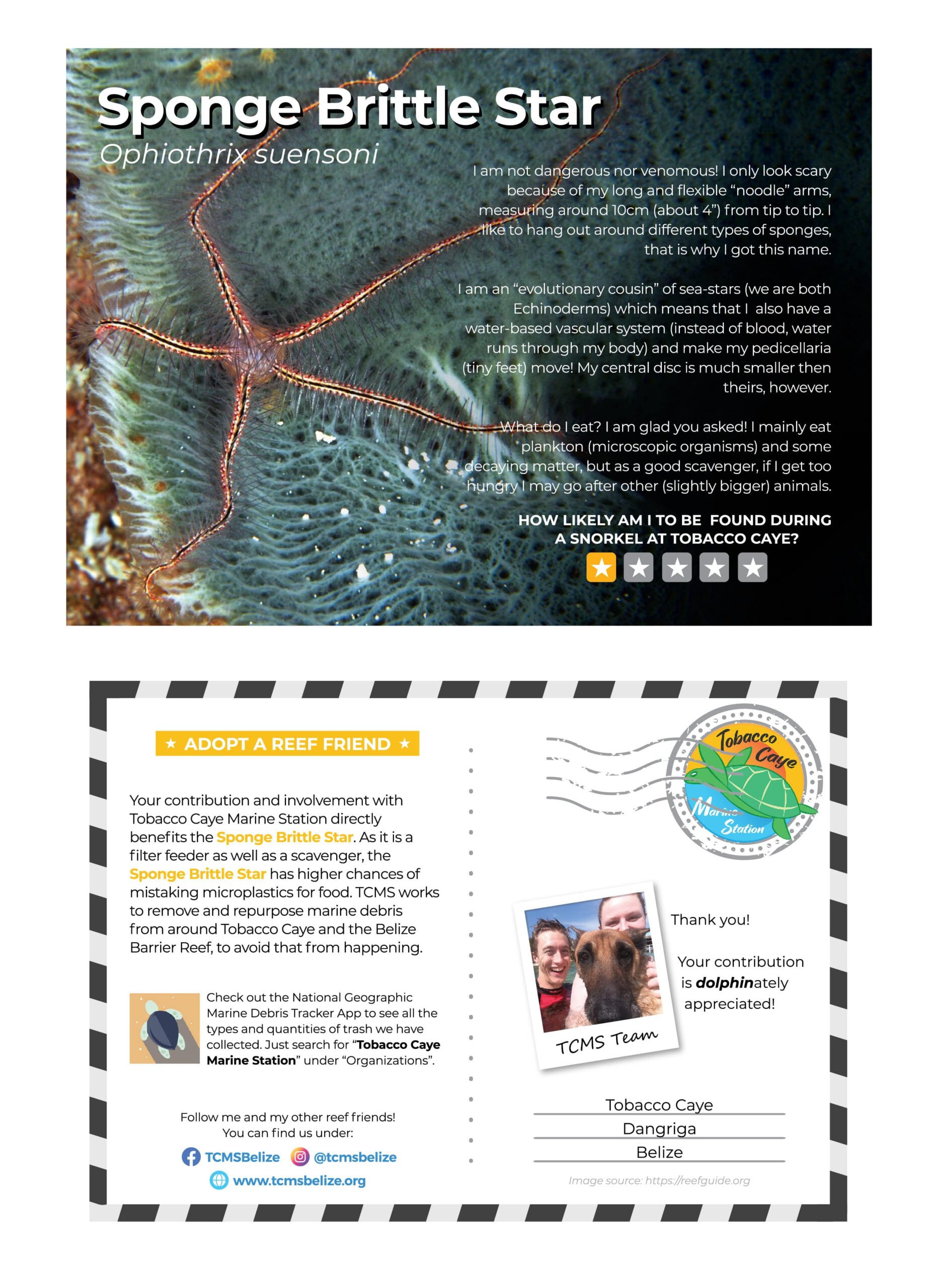
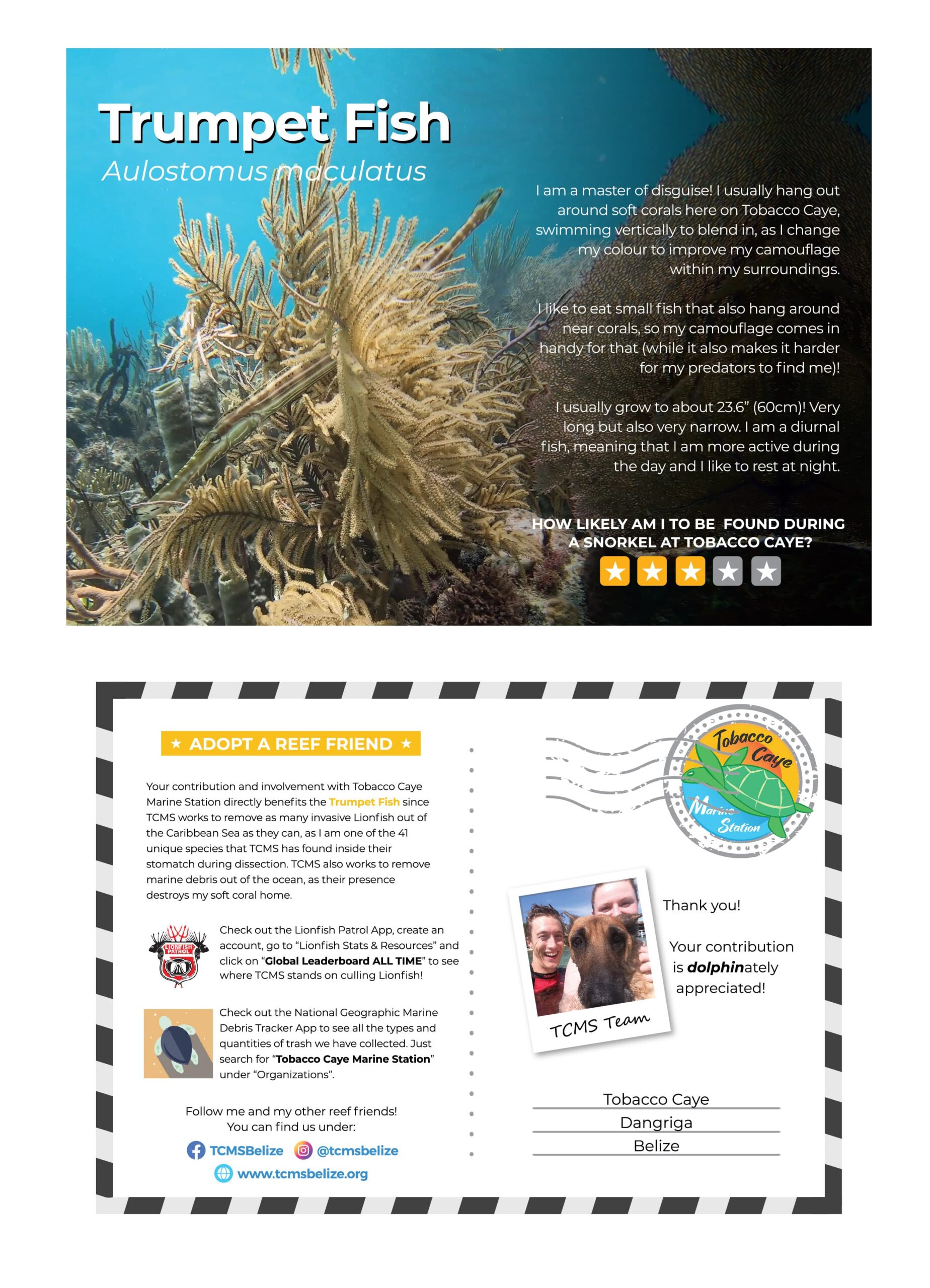
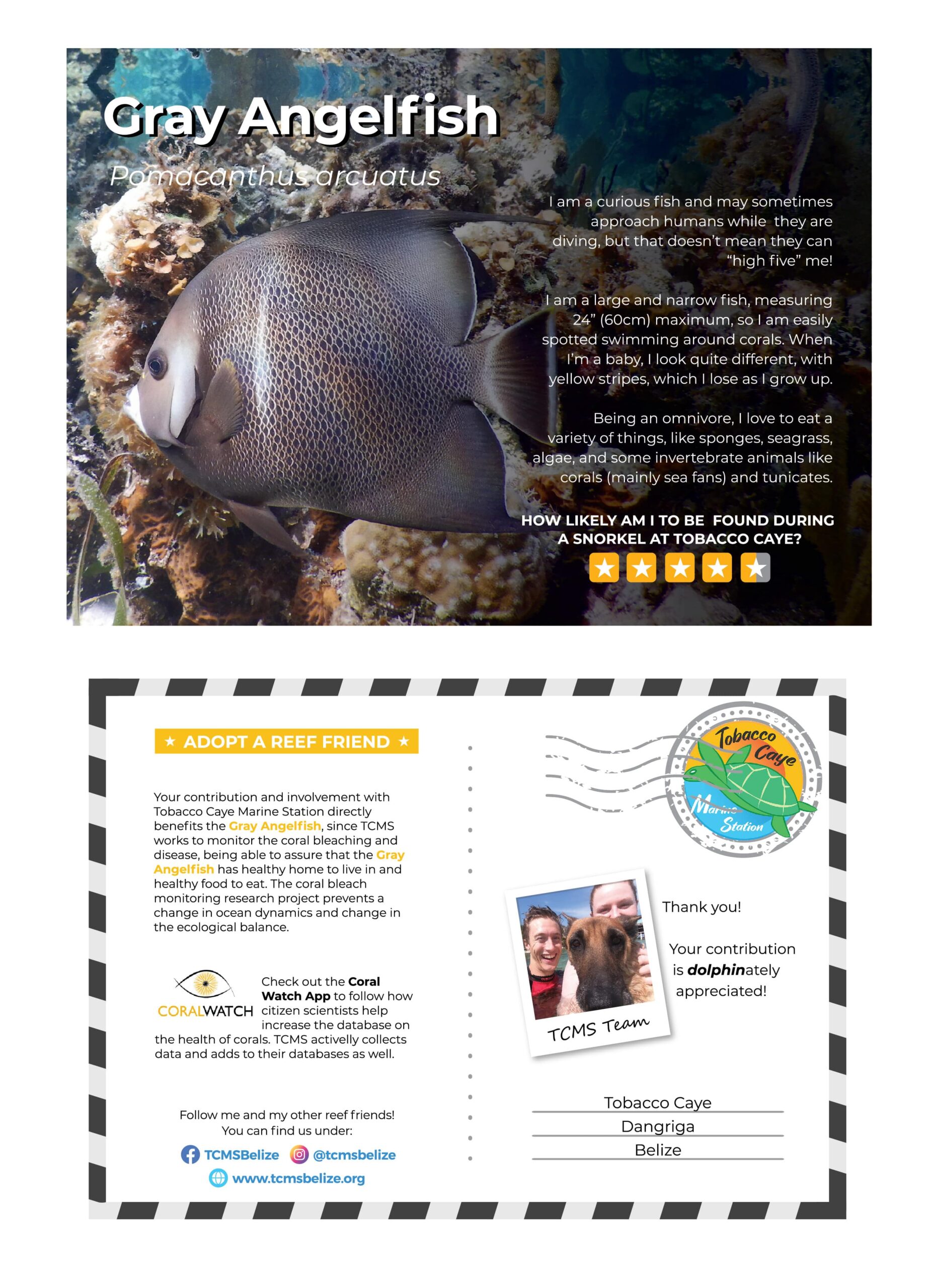
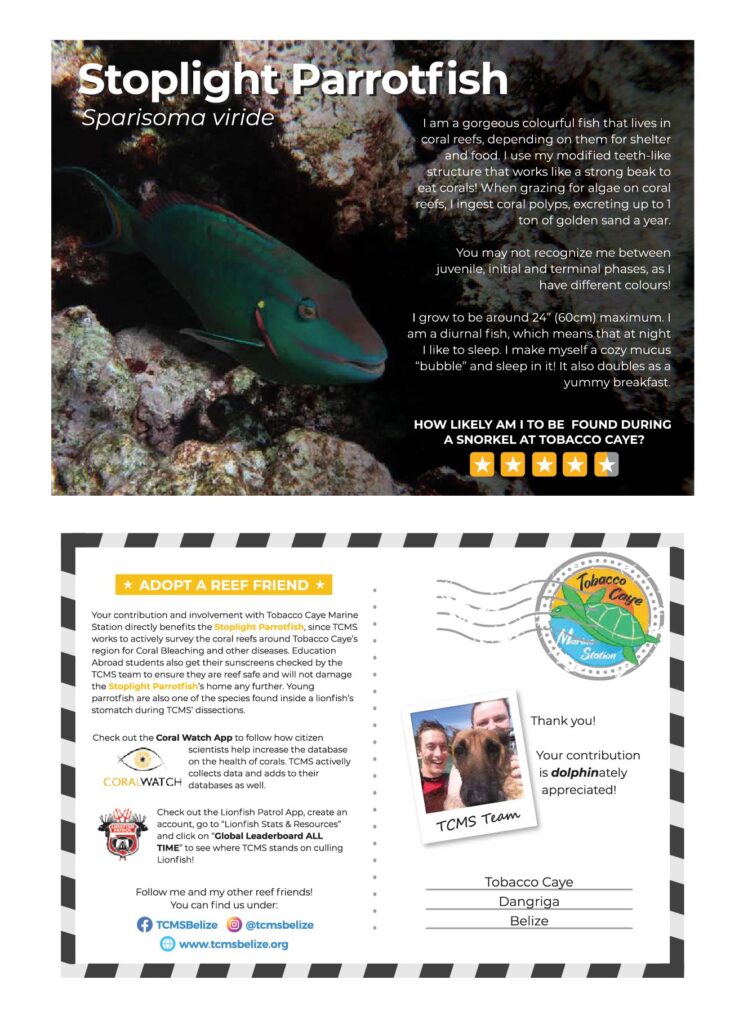
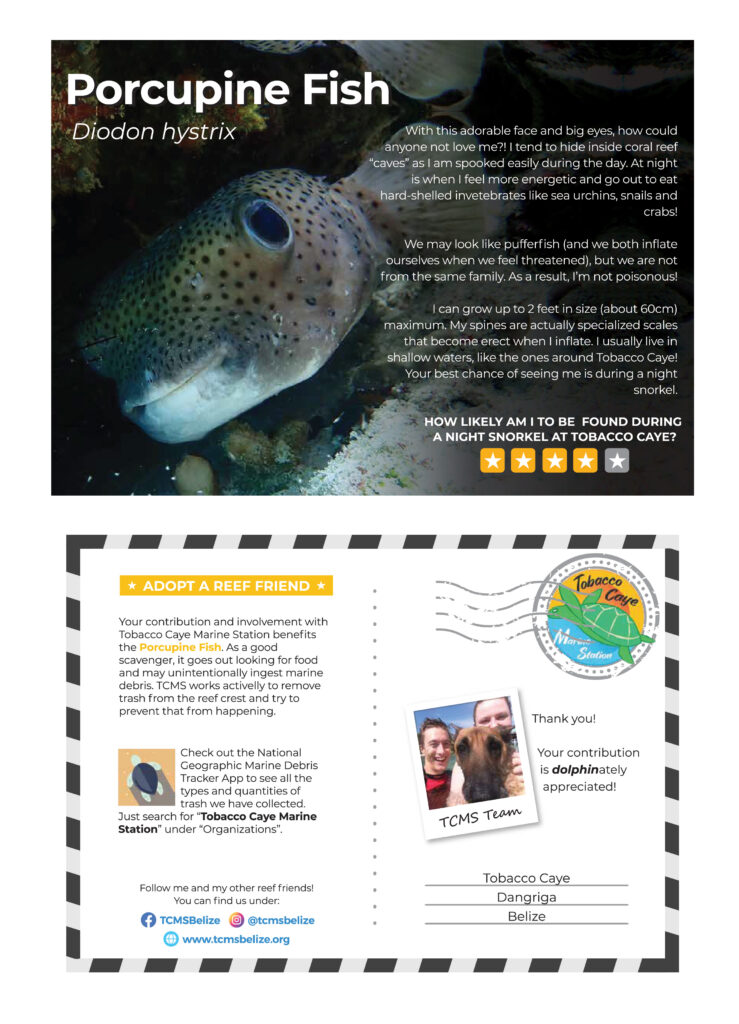
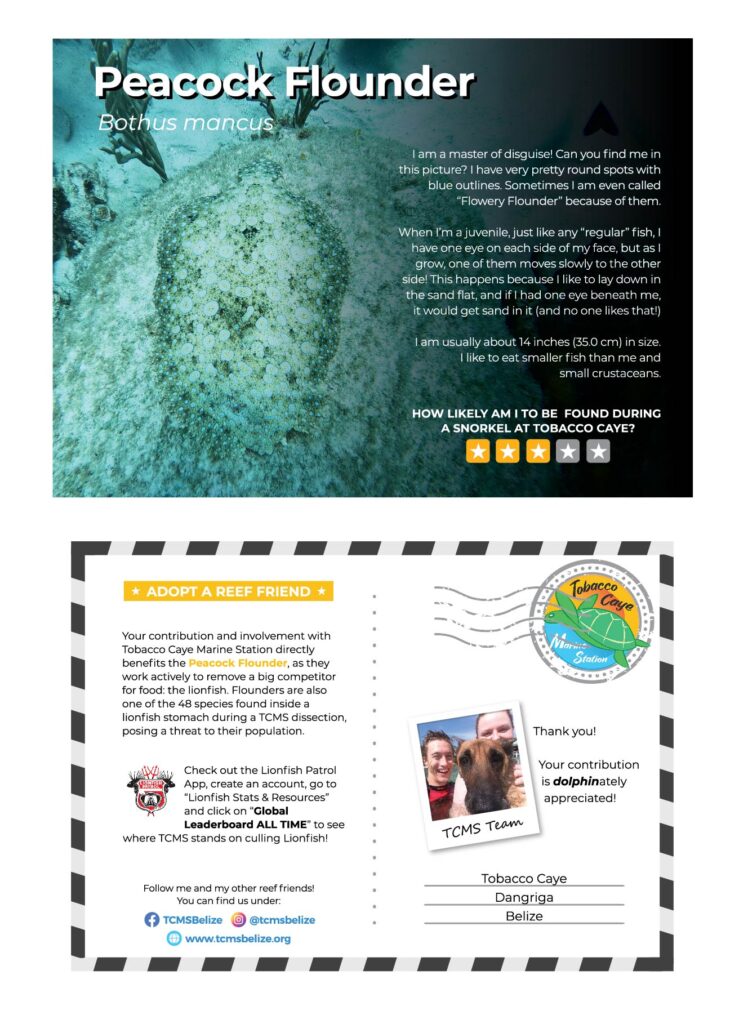
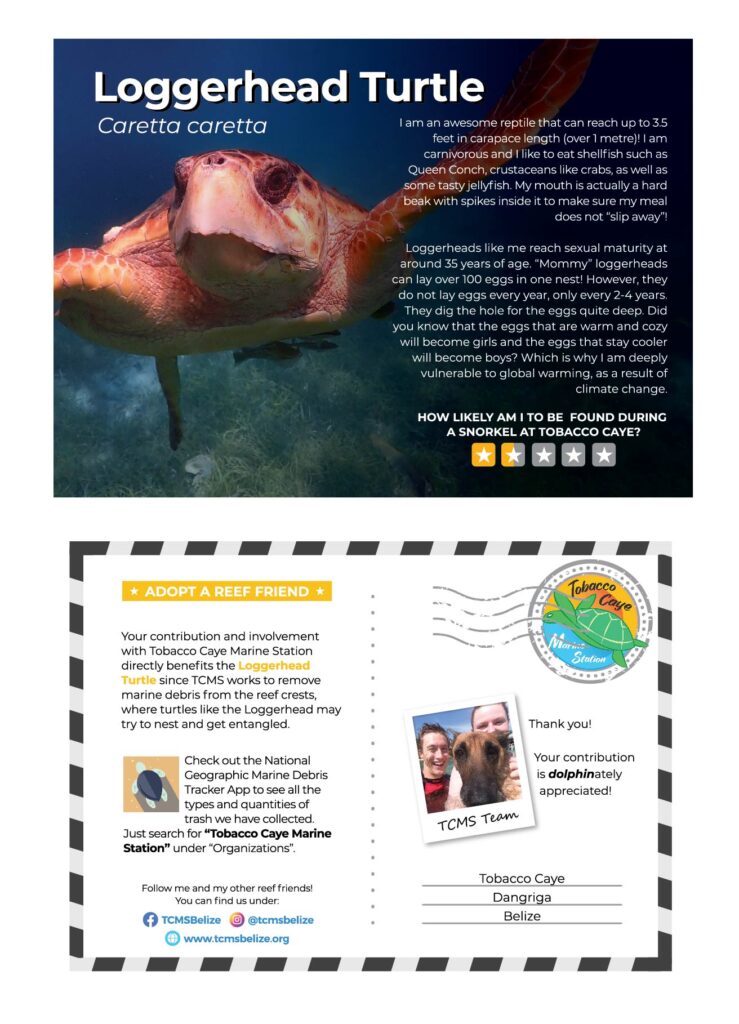
June 19th 2022 – Report 3: Lionfish Research
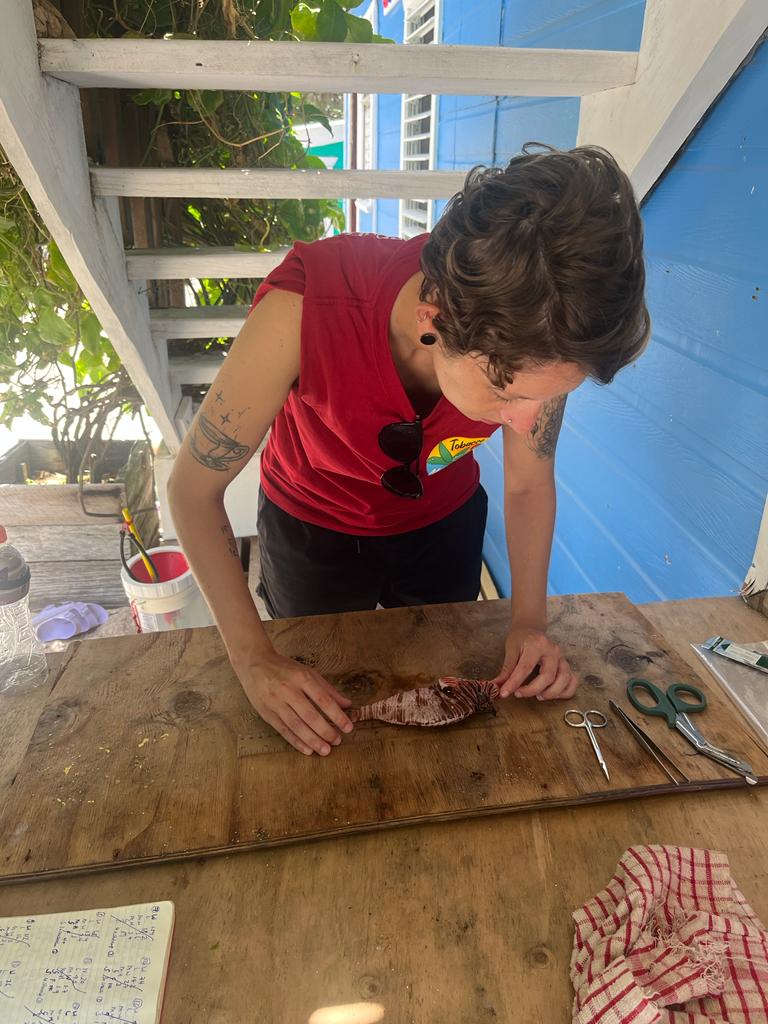
Lionfish (Pterois sp.) are a veracious predator species of fish that are invasive to the Caribbean Sea. Their natural habitat is the Indo-Pacific Ocean, where their population is kept in check by their natural predators, such as groupers and sharks, for example . Although the Caribbean Sea also has types of groupers and sharks, those are not habituated to the lionfish’s presence and do not consider them a potential prey, while also not having natural antibodies to the neuro-muscular venom lionfish possess.
As mentioned previously on my first blog report, lionfish have been introduced to the Caribbean Sea via human means, more specifically the pet trade. A few lionfish were spotted in Belize in 2008 and in 2009 they were already fully established. It is estimated that their original population, the one that gave rise to the other many thousands, were of about 10 fish only, exemplifying how their growth has been exponential and constant.
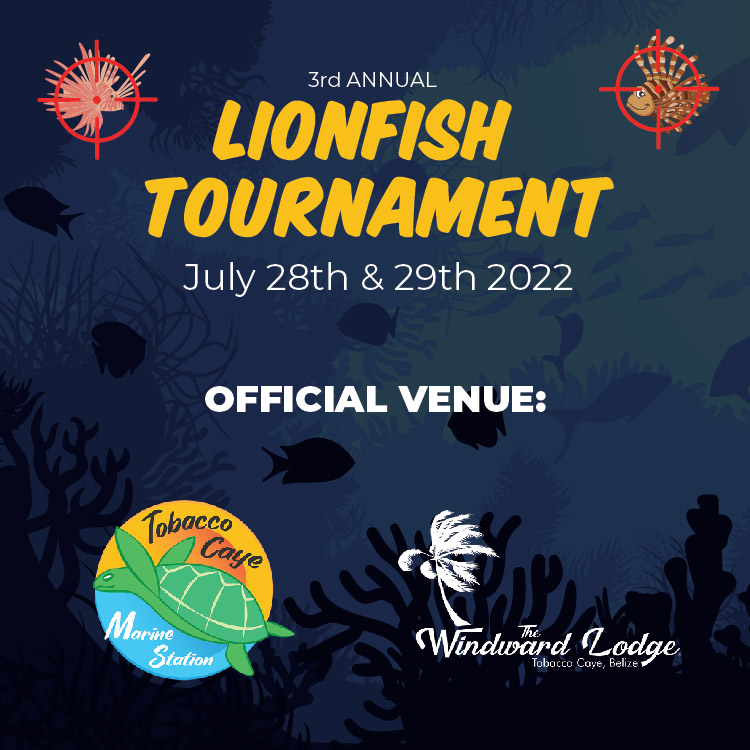
Tobacco Caye Marine station dedicates a lot of its time and effort to minimize as much as possible the detrimental impact that the lionfish has here in the Caribbean Sea. Not only do they catch lionfish themselves whenever possible, they also incentivize locals to fish them, as well as holding Lionfish Tournaments annually. This Summer the Lionfish Tournament will occur in July 28th & 29th. The Tournament’s focus isn’t to *just* remove as many lionfish as possible, but also increase local awareness towards lionfish’s negative impact in the local environment as well as encourage locals to bring the delicious lionfish meat to their table (filleting competition included!). It is possible to participate and support the Lionfish Tournament even if you do not plan to be on the island during those days, by simply connecting to watch the Live transmission on the Facebook Event page, following the social media posts on Facebook as well as on Instagram, or purchasing the Lionfish T-Shirt from TCMS’ website.
Lionfish do not swim in schools, meaning they are often seen alone. The most efficient way of capturing them is by spear-fishing one by one, which is time consuming but it works. The lionfish are then inserted into a special collection cylindrical containment unit made by Zookeeper, which not only ensures that the lionfish do not escape, but it also ensures that their catchers are not accidentally harmed by any of its 18 venomous spines.
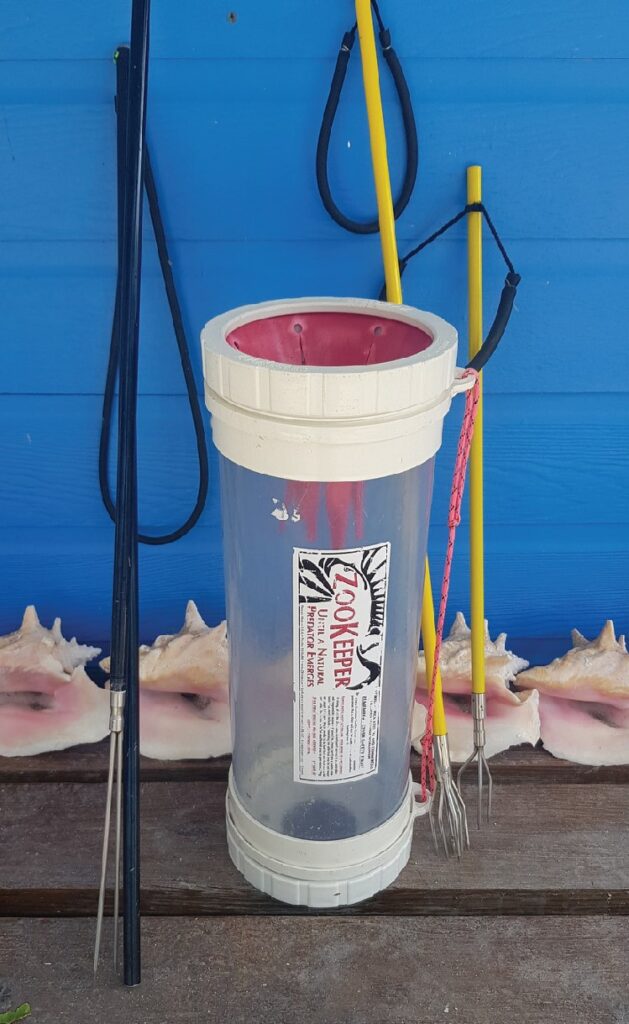
SIDE NOTE:
VENOMOUS vs POISONOUS… What is the difference?!
Venomous = it “bites” you!
(injected)
Poisonous = you bite it!
(ingested)
Since new management took over the Tobacco Caye Marine Station in 2019, TCMS has helped remove 1,448 lionfish from the area (data as of June 2022)! 764 lionfish were removed in 2021, which is an incredible amount, specially when compared to 47 lionfish removed in 2020 and 29 lionfish caught in 2019. In the first 6 months of 2022 TCMS has already surpassed 600 lionfish culled, which is incredibly promising to break last year’s record. Part of the astonishing increase in the number of lionfish captured was the fact that during the beginning of COVID-19 pandemic many local fishermen were struggling for income. TCMS then created a bounty for lionfish which provided them with an alternative means to generate some revenue.
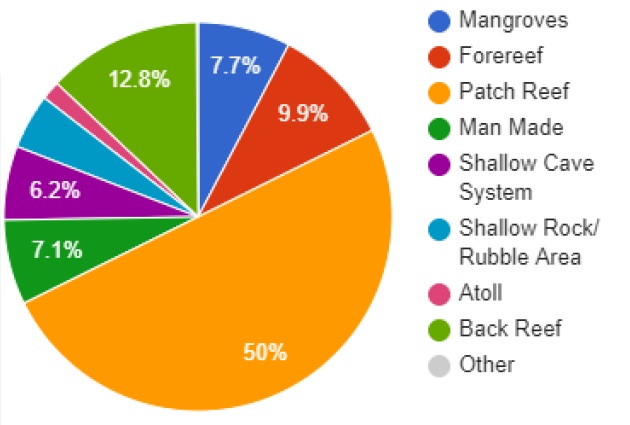
The success of this strategy was such that 127 lionfish were caught in just one day! The Lionfish Tournament hosted by TCMS in 2021 was also one of the biggest causes of the increase in number of lionfish caught. On the Tournament of July 7th 2021 alone, 215 lionfish were captured. The majority of the lionfish caught during the Tournament was found during the day and in patch reefs of depths from 15-25’ (4.5-7.6m). It is easy to observe that lionfish are able to populate a large variety of habitats, making their spread even more worrisome. The graph image on the right shows data of the year 2021.
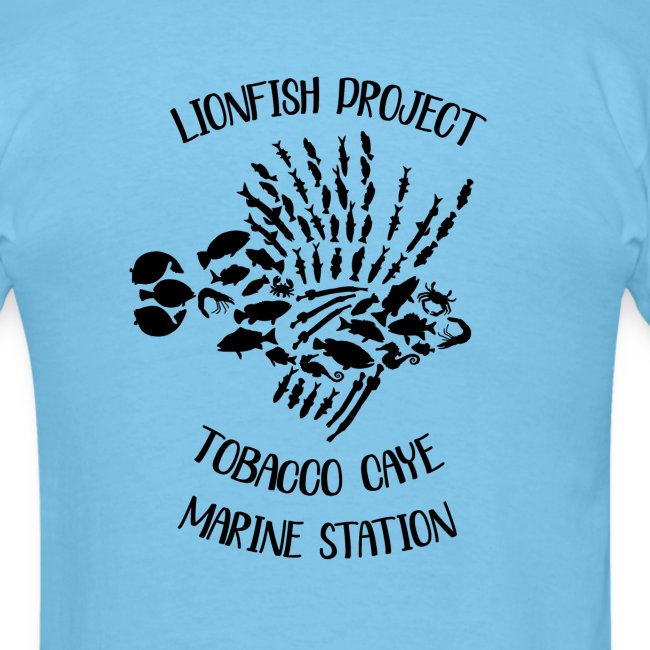
It is possible to identify the species of the prey that the lionfish has eaten (as long as it’s not too digested), as they swallow their prey whole. TCMS’ findings show that long, thin and solitary species are the most vulnerable to lionfish predation. So far, it has been possible to identify the following animals inside lionfish’s stomach: juvenile parrotfish and wrasse, shrimp (such as red banded shrimp), goby, damselfish (bicolour, longfin and threespot), crabs, sardine, seahorses, snapper, French grunts, juvenile grouper, juvenile big eye fish, flounders, lizardfish, filefish and trumpet fish. Whew! That is a lot to take in (pun intended). These species are not only vital to the balance of the coral reef’s ecosystem due to their unique ecological role, but many are also economically important for Belize’s population. On the back of TCMS’ lionfish t-shirt, the lionfish illustration is made out of animals found by TCMS in the lionfish’s stomach in dissections.
During the dissections, the following data is collected: Weight, Standard Length (snout to base of caudal fin), Mouth Width, Mouth Height, Sex (and if Female, how far she is into producing viable eggs) and stomach contents.
(NOT SO) FUN FACT: Lionfish are able to engulf prey up to 2/3 their size. This is equivalent to a nearly 6’ adult human eating an adult sheep in one bite!
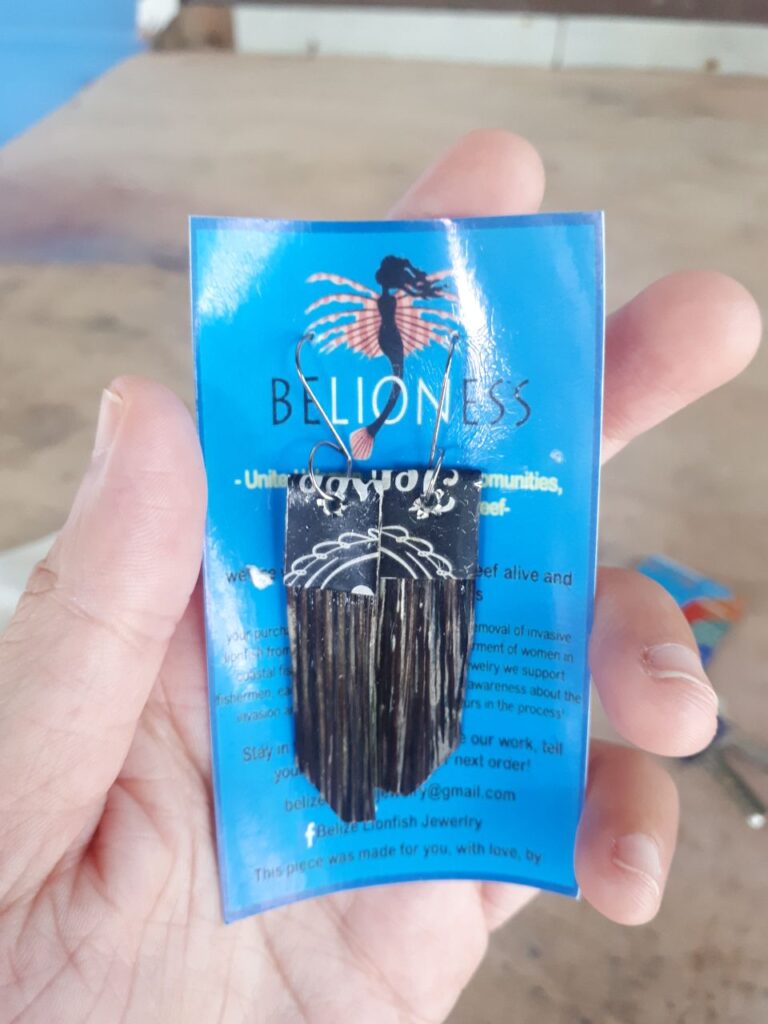
After dissection, the caudal fin of the lionfish (which does not contain any of its venomous spines) is cut, preserved in low temperature and sent to the wonderful BeLioness women’s collective, based in Caye Caulker. There, they are transformed into beautiful earrings, bracelets/anklets and necklaces, all of which are sold in the TCMS’ gift shop. The lionfish jewellery is not available online due to their one-of-a-kind nature and due to being a popular item purchased by education abroad students, making their inventory go faster than manageable to update online.
June 26th 2022 – Report 4: Coral Bleaching
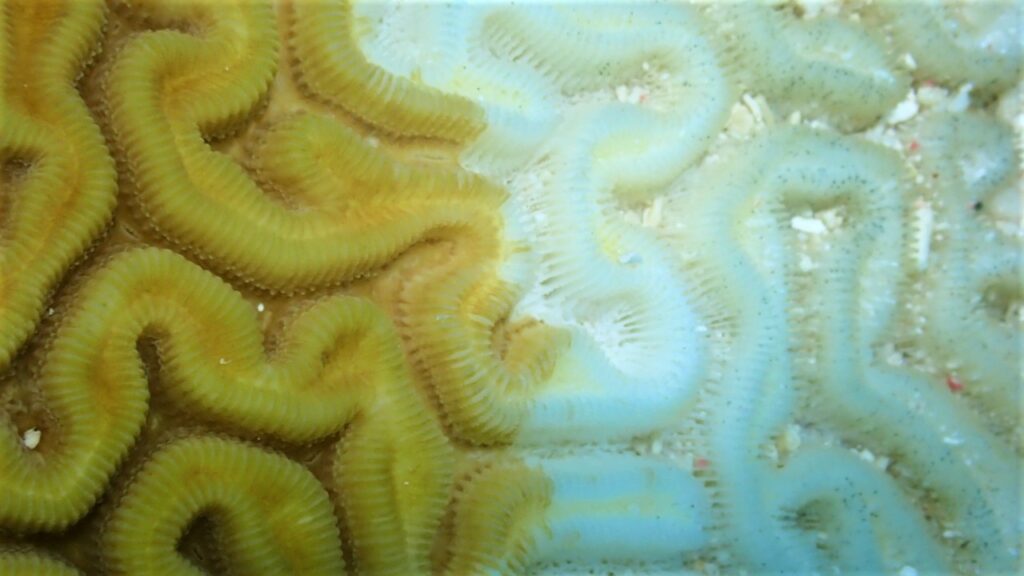
Any type of discoloration in corals can be called a “bleaching event”. The main causes of bleaching are: environmental stressors and disease where symbiotic algae are expelled from the coral polyps. The aforementioned is the more commonly known one. Corals have a “little friend” that lives inside the tissues of their polyps, called zooxanthellae, which is a microscopic unicellular alga that gives the coral some much needed supply of oxygen and carbohydrates (as well as their coloration), while they get a safe place to live in return, as well as an abundance of nutrients (carbon dioxide, nitrogenous and phosphorus wastes) from the coral [INFO SOURCE].
In other words, the coral polyps and the alga need each other to survive. When the corals feel stressed (for reasons I will get to very soon) they end up expelling their symbiont alga, making them lose their colour (“bleach” out), becoming weaker and more susceptible to mortality. This means that when we see white/bleached corals, they are not dead and there is still hope for recovery.
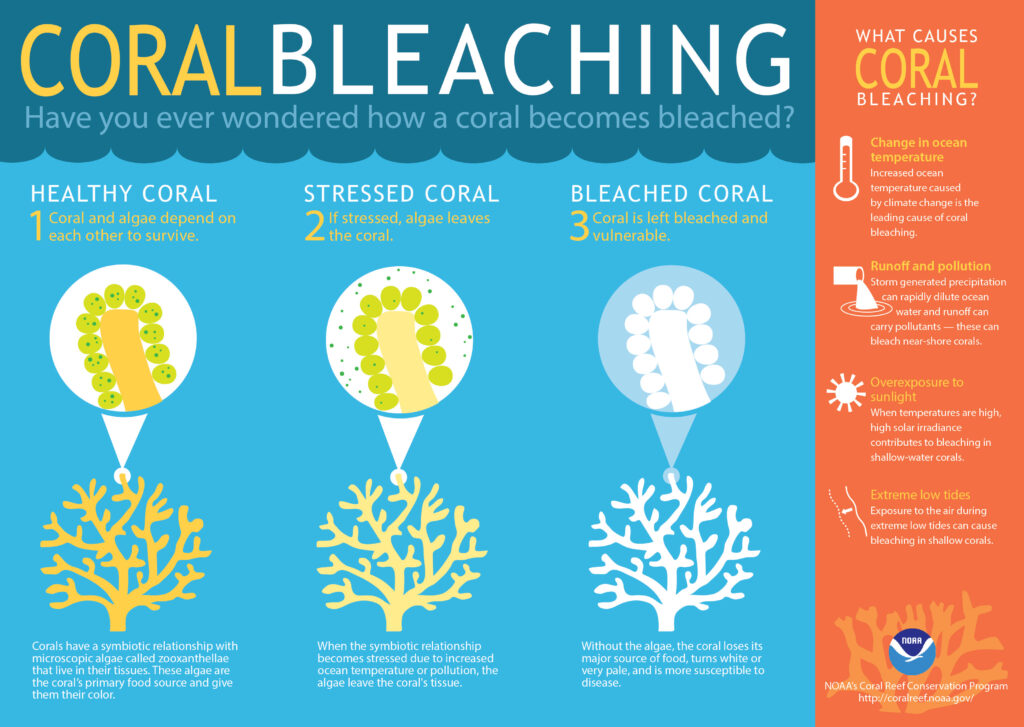
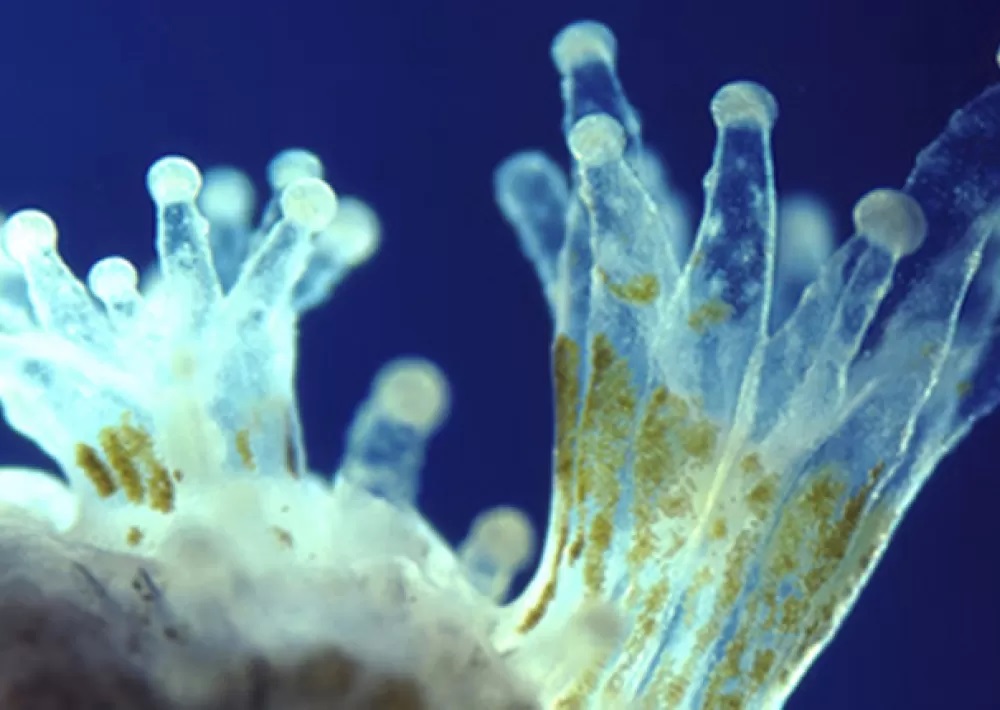
WHAT MAKES THE ZOOXANTHELLAE BE EXPELLED? As the TCMS station manager James Troughton likes to put it, coral are sensitive organisms that live in a “goldilocks” zone, meaning they are sensitive and “picky” with the environment they are in. When that very delicate balance is disturbed, it causes the corals to expel their zooxanthellae. The balance can be disturbed by a variety of reasons, such as a drastic water temperature increase (or decrease), too low or high salinity, an increase in the water’s turbidity (limiting the amount of sunlight that can reach the corals) or a significant decrease of turbidity (making more UV light reach the corals as usual), as well as increase in water pH and, of course, pollution. If any of these disturbances are short-lived, such as an El Niño event, the corals will very likely recover. [INFO SOURCE] The image on the right shows a close-up of a coral polyp, where it is possible to see the microscopic zooxanthellae alga in the coral’s tissue.
But why wouldn’t they KEEP their “helpers” in a situation of stress?
It is believed that corals expel their symbionts (that are intolerant to the new/changing conditions) on the chance that they may be able to acquire “stronger” zooxanthellae to replace them. [INFO SOURCE]

WHAT CAUSES (long-term) DISTURBANCE IN WATER? In short, humans (ie. human-induced climate change). In a not-so-short answer, ocean acidification caused by the increase of CO2 in the atmosphere (which is absorbed by the ocean water, in a constant automatic chemical response to achieve equilibrium), pollution, unsafe sunscreen with chemicals that harm corals. Other non-human causes for the coral’s environment disturbance are hurricanes, which can turn branching corals – such as Elkhorn (Acropora palmata) and Staghorn (Acropora cervicornis) – into coral rubble.
Tobacco Caye Marine Station makes sure to analyze the sunscreen each student brought to the island, actively looking for a mineral based component such as titanium dioxide and zinc oxide. In the case of the students not having a reef-safe sunscreen, the station has the Pearl reef-safe sunscreen, which is Belizean made, processed and packaged.
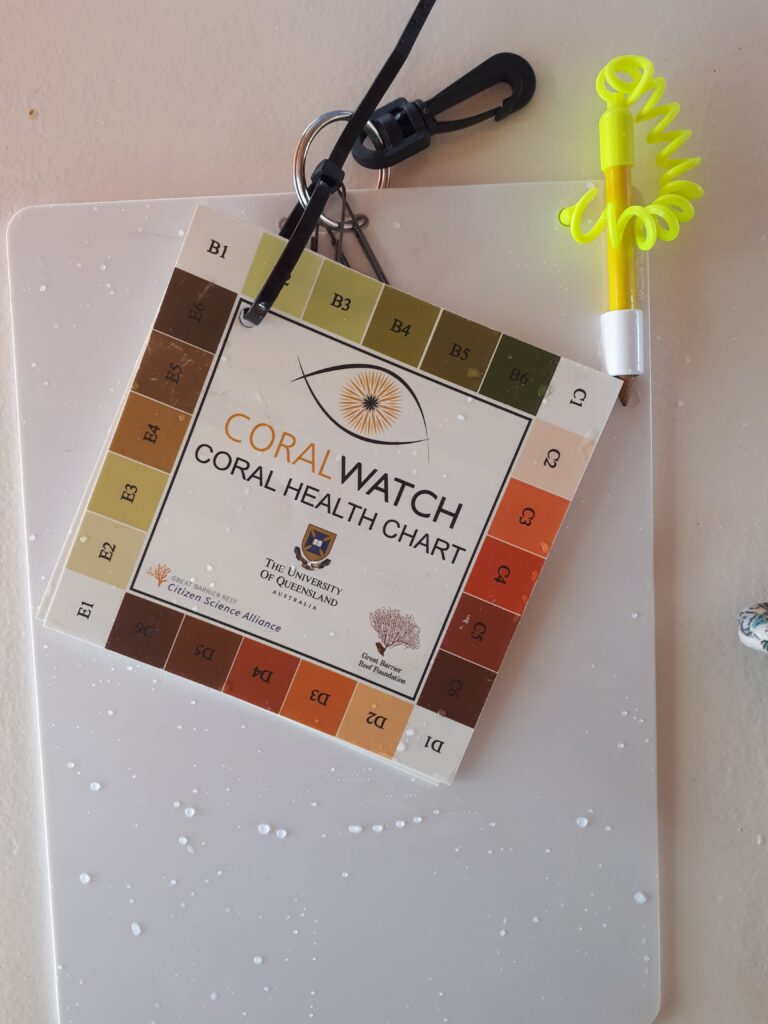
The Marine Station has partnered up with Coral Watch, which is a not-for-profit citizen science program based in Australia, in who’s main purpose is to classify corals according to their colour chart, anywhere in the world, by annotating the lightest and the darkest shades observed within the same coral colony. The image on the left shows the Coral Watch chart I’ve used multiple times during my data collection surveys. The simplicity of the chart is on purpose, as it aims to reach a wide variety of “coral watchers” of different ages and backgrounds.
Here at the Tobacco Caye Marine Station, the station manager has been incorporating an additional element to the coral bleaching observations to make them more complete and less vague: annotate if they have been caused by a disease and if so, which disease it is.
Little is known about what causes the diseases or how corals contract them. The number of identified diseases has increased since the 90’s, some spreading and killing coral tissue more rapidly than others. Stony coral tissue loss disease was discovered in Florida in 2014, for example. The most commonly observed diseases are: White Band, Black Band (a “ring” formed around the bleached area is clearly seen), White Plague disease, as well as White Patch disease (where non-uniform and “goo-looking” patches are observed in the corals). Another disease observed is the Stony Coral Tissue Loss Disease.
Coral diseases are closely associated with marine microbes (tiny bacteria, viruses and protists) but more research is needed to confirm if they are the cause, the symptom or just the consequence of the diseases.
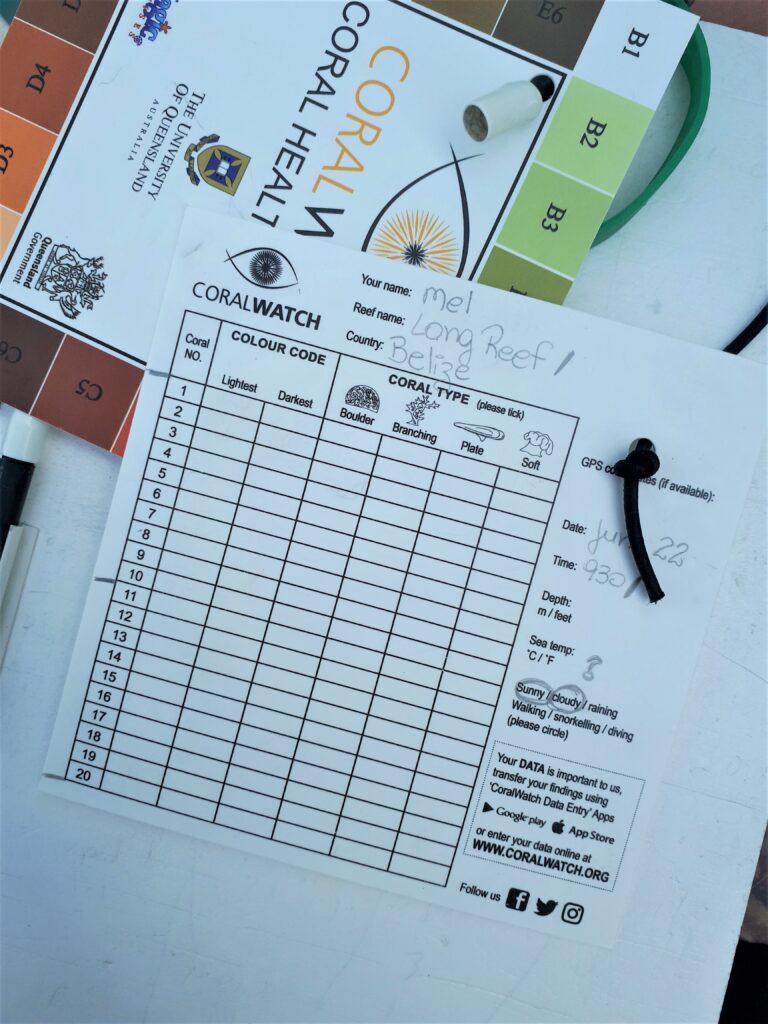
It can be noticed that the colour chart does not include the shades of purple and blue from many gorgonians (sea fans), as their health assessment is done in a different way due to their different bleaching responses. It is known that human’s land-based activities has introduced a soil fungus to the purple sea fans, which get to the oceans from run offs from rivers, causing the aspergillosis disease. Sea fans are also impacted by tumors (dark purple growth patches), Red Band Disease and can be overgrown by fire coral.
In my experience collecting data in multiple sites around Tobacco Caye, it was clear the difference between one location to another, not only in terms of coral health, but also their biodiversity and the diversity of fish around them. A clear example is how the site called “Long Reef” compares to two other sites, “3rd Cut” and “Aquarium/Garden”, all surveyed in the same day. The latter two sites are vibrant with diverse fish and coral colours, and although coral bleaching is visible, it tends to not dominate the majority of the coral, which is what I saw happening at the “Long Reef” site.
In my personal experience it was initially quite difficult to identify and classify the four main types of coral structure: boulder, branching, plate and soft corals. It is also a bit tricky to separate the normal and expected bleaching caused by predation of parrotfish (Scaridae sp.) and damselfish (Chrysiptera sp.) , for example, from the unwanted white spots from coral bleaching as a result of environmental stressors.
NOTE: Fire Corals are not true corals (they are hydrozoans, capable of encrusting into corals and “taking over” their place), and therefore are not surveyed as part of the Coral Watch bleaching chart.
Information source includes the Reef Coral Identification – Florida, Caribbean, Bahamas – by Paul Humann and Ned DeLoach very complete guide.
July 15th 2022 – Report 5: Final Experiences
Reflecting on my experiences in Belize while getting used to being back home again is something emotional and a bit bittersweet to go through. From the small comforts like a warm shower (even warm tap water!) and getting and ice capp, to the huge and blinding comforts like being able to throw my garbage away and not *need* to worry about where it is going to end up next. During my internship at Tobacco Caye Marine Station is was really clear how plastic and other marine debris are an immense problem (ok, nothing new here) but I now recognize a lot more the effort that they made into making sure no trash goes to landfill and how pressing this matter gets when the land is limited. The same goes for the usage of water. The island did not have access to drinking water, so it needed to be brought in from the mainland. Rain water was collected and used for showers and other needs. This a sustainable way of living, although limiting, and it forces you to do your part and ensure your neighbours have access to water too.
I absolutely adore seeing the several meters tide that come and go every day here on the West Cost of Canada. The definition of “high tide” on the island was about a 30cm different in water height only. But don’t get me wrong, if you’re kayaking that makes all the different to not get stuck (trust me, learned by experience haha)!
I believe the the long periods of time without days off certainly drained me and I unfortunately could not perform as well as I wanted at some points of the internship.
I miss the fluffy sand and the graceful stingrays. I do not miss the mosquitoes/flies/roaches and I don’t miss feeling sticky (from sunscreen, sweat or both) 24/h day. I miss the delicious food and the warmth of the central-American people.
It pains me a little to hear north-Americans complain about road constructions while I spent a few weeks in a country where the road signs are worn out and difficult to read, and pavement wasn’t taken as a given. That is what experiencing different parts of the world is for, and try to be as grateful and understanding as possible.
My experience as an intern has truly cemented my path into the marine sciences and I could not be more grateful to the Queen Elizabeth Scholarship Award for this dream-come-true.